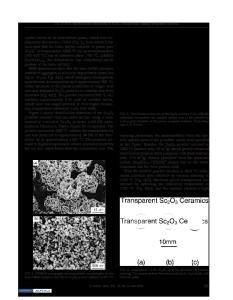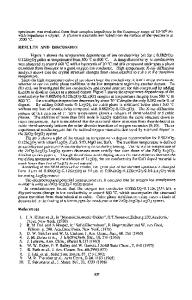Preparation of Yb-Doped Sc 2 O 3 Transparent Ceramics for Laser Applications
- PDF / 1,271,276 Bytes
- 6 Pages / 612 x 792 pts (letter) Page_size
- 101 Downloads / 340 Views
1111-D01-06
Preparation of Yb-Doped Sc2O3 Transparent Ceramics for Laser Applications L. Longuet, A.C. Bravo, D. Autissier, P. Vissie, J.L. Longuet, S. Lambert CEA DAM Le Ripault, F37260 Monts, France
ABSTRACT Polycrystalline transparent Yb:Sc2O3 ceramics were obtained in the best conditions by a solid-state reaction route using high purity Sc2O3 and Yb2O3 powders with TEOS as a sintering aid. The as-prepared powders containing various ytterbium content were characterized by BET measurements, XRD and FEG-SEM. The sintering behaviour of the powders was investigated by dilatometry. The sintered materials microstructures were observed by FEG-SEM. EPMA allowed to characterize the repartition of the dopant Yb3+ in the Sc2O3 matrix. INTRODUCTION Pore-free ultra pure ceramics are of great interest in the field of the solid state laser sources. Indeed, they present several advantages such as higher thermal conductivities than glasses, lower fabrication costs than single crystals, and they also show the possibility of making large pieces. Thus, transparent ceramics appear as promising alternatives for laser applications. Rare earth sesquioxides have been already shown as encouraging matrix hosts for high power solid state lasers [1] and in particular scandium sesquioxide which presents very interesting laser properties when moderately doped with Yb3+ [2-3]. In this study, we present the elaboration of ceramics obtained by a classical ceramic route consisting in processing the commercial oxide powders of Sc2O3 and Yb2O3 in order to obtain YbxSc2-xO3 materials with x = 0.02 and 0.2. The materials are shaped by uniaxial pressing and then are sintered under vacuum. The characteristics of the powders (particle size, purity…) and the sintered materials (final density, microstructure, homogeneity …) are presented. The aim of this study is to show the feasibility of producing transparent Yb doped Sc2O3 by a classical ceramic route. EXPERIMENTAL The Yb:Sc2O3 powders were prepared by a classical ceramic way. High purity Sc2O3 (99.99%, Neyco) and Yb2O3 (99.99%, Rhodia) powders were used as starting materials to prepare YbxSc2-xO3 ones with x=0.02 and 0.2 also respectively further noted Yb(1at.%):Sc2O3 and Yb(10at.%):Sc2O3. A previous work about the composition Yb0.02Sc1.98O3 showed that both a grinding step and an addition of SiO2 as a sintering aid were necessary to enhance the sintering [4]. Sc2O3 and Yb2O3 were consequently mixed in aqueous medium with a 0.5 wt.% addition of tetraethylorthosilicate (TEOS). Then, the mixture was grinded by attrition for 75 minutes with φ8 mm zirconia balls. The powders were dried at 60°C. They were all shaped into cylindrical samples by uniaxial pressing under 150 MPa.
The materials were sintered under vacuum in the 1700°C-1800°C range for 2, 5 or 10 hours and annealed in air at 1550°C for 1 hour. The Brunauer-Emmett-Teller (BET) surface areas of the powders were measured with a specific surface area analyzer (Micromeritics ASAP 2010). Structural and microstructural investigations were performed
Data Loading...











